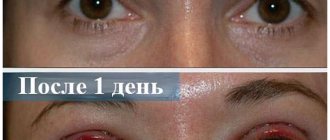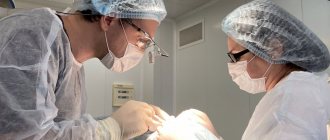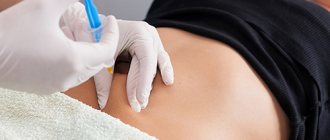The passing of the years inevitably leaves an imprint on the face. In order for the mirror to continue to please even in adulthood, you can and should use all the resources of your own body, in particular, fat cells. Specialists at the Medial aesthetic medicine clinic invite you to a lipofilling procedure that will help get rid of unwanted age-related changes. By resorting to injections of your own fat, you can correct congenital asymmetry of the face, eliminate cosmetic defects in the temporal zone, cheekbones and cheeks, lower eyelids and chin.
Correction zones
- Lips. Procedures to enlarge and reshape lips are now at the peak of popularity. However, correction with gels has to be repeated constantly, but lipofilling will only need to be done once. This is especially true if you do not want to increase the volume of your lips, but would not mind returning them to their former juiciness.
- Dark circles under the eyes. “Dips” and dark circles under the eyes are usually difficult to correct, but lipofilling easily copes with this task: in addition to replenishing volume, fat transfer leads to a noticeable improvement in the quality of the skin.
- Cheeks and cheekbones. The drooping of the tissues of the middle zone of the face leads to the appearance of jowls and deep nasolabial folds, blurring the contours of the lower jaw. To return a clear contour to the oval of the face, you will need to uniformly inject fat into the recessed areas.
Point injections smooth out nasolabial folds, nasolacrimal depressions, “dips” in the cheekbones and temples, create a gentle oval on thin, pointed faces, and improve the relief of the neck and décolleté. Lipofilling is absolutely indispensable for rejuvenating the hands when you need to smooth out protruding veins and tendons.
Is it worth having surgery?
Due to such nuances as the impossibility of strong enlargement or possible complications, patients sometimes doubt the need for surgery. Sometimes, instead of lipofilling, it is better to turn to other procedures - for example, using fillers instead of fat or performing another operation (blepharoplasty, augmentation with implants, and so on).
The appropriateness of the correction is determined by the surgeon. The main thing is to go to a trusted clinic and see qualified specialists. If the doctor recommended this method, you should be careful about caring for your body during the rehabilitation period. Only joint work between the doctor and the patient will allow achieving decent results and avoiding unpleasant consequences.
Benefits of lipofilling
The main advantage is that only the patient’s own fat cells are used for transplantation. And this eliminates the possibility of rejection, allergic reactions and other complications associated with the introduction of foreign products into the body. Other advantages of lipofilling include:
- lasting results after 1.5-2 months after complete engraftment of cells (according to statistics, 70-80% of transplanted tissues engraft forever);
- beautiful proportional contour;
- if desired and aesthetically necessary, the procedure can be repeated;
- Using the technique of transplanting your own fat cells, you can not only increase your shape, but also at the same time get rid of excess fat deposits in problem areas.
Lipofilling is often combined with plastic surgery. This combination allows you to get the most natural rejuvenation result. And if you want not only to restore volume to the tissues, but also to significantly improve the quality of the skin, you can combine the technology of lipofilling with nanolipofilling - in this case, the procedure will not only restore the visual attractiveness of the face, but will also have a powerful rejuvenating effect literally at the cellular level.
List of necessary tests
Procedures on certain areas of the face are performed under local anesthesia. So that the doctor can predict the result as accurately as possible and assess the condition of your body, you will need to undergo the following tests:
- general clinical blood test (complete + platelets);
- coagulogram (blood clotting time, bleeding time, INR, prothrombin index, fibrinogen, APTT);
- blood sugar (glucose) test;
- examinations for hepatitis B, hepatitis C, HIV, syphilis
*To assess the condition of the body and outline the optimal amount of correction, the doctor can individually prescribe an extended list of studies for you.
Rehabilitation period after lipofilling
Rehabilitation after facial liposculpture is very comfortable and short. It can be characterized by slight swelling and hematomas in the area of harvesting and implantation of adipose tissue for 6-8 days from the date of surgery. Final rehabilitation occurs after 4-6 weeks.
IMPORTANT!
- Lipofilling has virtually no contraindications; your own fat is not rejected by the body and does not cause allergies, which makes the lipofilling procedure not only effective, but also safe.
- The patient's adipose tissue is a real elixir of youth! Your own fat, restoring lost volumes, becomes an invaluable source of your own stem cells, which are of great importance for maintaining youthful skin.
- Lipofilling is perfectly combined with any surgical methods of facial rejuvenation, allowing you to achieve the most natural and long-term rejuvenating effect.
Contraindications to the procedure:
- chronic diseases in the acute stage;
- acute diseases of viral and infectious etiology;
- oncological diseases;
- diabetes mellitus type I and II, other endocrine disorders;
- connective tissue pathologies,
- disorders of the blood clotting system,
- lack of sufficient adipose tissue in the patient.
Please make an appointment for a medical consultation in advance and provide the doctor with truthful and as detailed information as possible about your medical condition. This will not only avoid possible complications, but will also increase the effectiveness of the procedure.
What percentage of fat survives after lipofilling?
Even 10 years ago, at plastic surgery conferences there were very active discussions about the percentage of fat engraftment: one part of the surgeons claimed that the engraftment rate was about 10-20%, the second - about 50%, the third - up to 70%. And each of them was actually right. The problem was that each doctor’s method of collecting and injecting fat was different.
Fat grafting seems to be a fairly simple plastic surgery at first glance, but in fact the fat transfer process has a lot of nuances, which subsequently affect the percentage of engrafted fat:
- Incorrect fat intake. If you introduce too much solution at the liposuction stage (which makes fat collection easier and bleeds less), then the percentage of fat cells per ml of the injected component will be much less, and accordingly the engraftment result will be worse.
- Using a centrifuge after fat collection. Nowadays, the use of a centrifuge is not recommended, since it separates fat cells (adipocytes) from stem cells, which end up at the bottom along with the solution and then merge, which also leads to a lower percentage of engraftment.
- After collecting the fat and placing it in a container, it is extremely important to stir it! If this is not done, the fat is divided into fractions and quickly, literally in 2 minutes it is already fragmented: at the top - oil, in the middle - fat cells, at the bottom - blood. For example, if a nurse who gives a ready-filled syringe to the doctor took one portion from the bottom, where there will be blood, and took the second portion from the middle, where there are a lot of fat cells, then naturally the result after administering the 1st portion will be almost unnoticeable.
- Bolus administration. If you inject fat with a thick cannula, as a bolus, you will get a large ball and naturally there will be a large percentage of fat cells that simply do not contact living tissue and therefore cannot take root. Fat needs to be injected in micro portions, and even with a thin cannula; this is very painstaking work. A thin millimeter cannula makes microchannels and with each pass we introduce no more than 1/20 of one cube. Imagine the difference of 1/20 of a cube or 10 cubes at once with a bolus injection. Doctors often sin with bolus injection, who perform several operations in one cut (for example, rhinoplasty + liposculpture) in order to save time. refilling the area under the eyes, cheeks and cheekbones
Complications
After surgery, some complications are possible, which are divided into ordinary postoperative effects and real complications. The first include:
- swelling,
- bruises,
- pain in the treated areas,
- increased or decreased sensitivity,
- slight rise in temperature.
These phenomena accompany every operation, and there is nothing terrible or abnormal about them. More unpleasant complications:
- l getting an infection,
- l appearance of seromas and hematomas,
- l uneven distribution of donor material,
- l the appearance of asymmetry.
In these cases, it is necessary to urgently consult a doctor to stop the problem at an early stage. But such complications are rather rare. Some of them appear due to the individual characteristics of the body, while others are the result of the work of an insufficiently qualified surgeon.
How long does it take for the fat to take root and when can you see the final result?
Engrafted fat is already present a month after lipofilling. But there are some fat cells that have not yet taken root as well. The entire metabolic process of engraftment and utilization of destroyed fat ends by 6 months and then we can see the final result. As for facial lipofilling, the result can be seen even earlier, because there is a good blood supply and small volumes of injection, and buttock lipofilling - no earlier than 6 months. From my experience, on average, 50% fat survives, so during lipofilling, you need to deliberately introduce excess fat, more than necessary, given that the volume of fat will decrease.
To prove the effectiveness of lipofilling, I can say that in Brazil and Colombia this is operation No. 1. Patients (often at a young age, so there is no sagging skin) have fat taken from the waist in a circle and injected into the buttocks on average 1-1, 5 liters each. And after 2-3-4 years, no one says that the buttocks have become much smaller. If fat had not taken root so massively, this technique would have been abandoned long ago. But there are also dissatisfied patients, to whom the fat was injected either poorly, or, on the contrary, it was too much (when a lot of it was injected), these are the 2 main problems of lipofilling.
Features of rehabilitation
When speaking about the pros and cons of lipofilling, the first thing we can mention is safety and a short rehabilitation period. From the body's point of view, its own adipose tissue is not a foreign body. Thanks to this feature, the risks of rejection, allergies or other unusual reactions to injections are minimized.
In addition, injections require several small punctures in the donor and recipient areas, so the tissue is slightly injured during the intervention. Of course, damaged tissue still needs time to grow new vasculature. But the healing process is quite easy. At this time, the patient must comply with all recommendations and prescriptions of his doctor, and also not violate the prohibitions. Attention is the key to good results and quick recovery.
What affects healing
First of all, it is necessary to remove sports and physical activity from life, especially when it comes to breast or buttock correction. It is also important to exclude thermal procedures - baths, saunas, hot baths. Heat promotes blood flow to injured areas and thereby increases the recovery period.
To recover, you also need to adjust your daily diet. During the rehabilitation period you will need to give up salt and spicy foods. Salt and hot seasonings retain fluid in the body, which increases the time it takes for swelling to resolve.
In the first days, puncture sites should be protected from water, and then protected from the sun. Solarium and beach are excluded for a month. When going out into the open air, injured areas should be protected from sunlight.
How quickly will the swelling go down?
Some factors that determine the speed of recovery do not depend on the will of the patient. These are, for example, age or genetic characteristics. The older the patient, the longer it will take for the swelling to subside. Patients with thin skin or low blood circulation also take a little longer to recover.
Other factors, on the contrary, directly depend on the patient. As an example, if an infection gets into a wound, tissue healing will take a very long time and be difficult. To prevent infection, it is necessary to treat punctures daily with an antiseptic.
The recovery time usually depends on the place that was corrected. Swollen areas on the face return to normal faster than on the chest or buttocks. External swelling usually goes away within a period of two weeks to a month. The internal one may persist for some time.
Medicines and physical therapy
Medicines and physical therapy procedures can also help remove swelling after lipofilling. Medicines include Traumeel, heparin ointment or Troxevasin. A course of antibiotics may also be prescribed to stop the infection.
From physical therapy, patients are most often recommended microcurrents, laser, magnetic or phototherapy. These procedures help resolve swelling and speed up healing.
Microcurrent therapy accelerates resorption.
It is important to remember that you absolutely cannot prescribe medications and procedures for yourself! All medical treatments and manipulations must be suggested by or agreed upon by a physician. Self-medication can only harm the patient. Before attending physical therapy or using medication, you should always consult with your surgeon.










